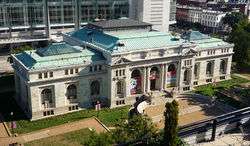List of Carnegie libraries in Europe

This is an incomplete list of Carnegie libraries in Europe.
Belgium

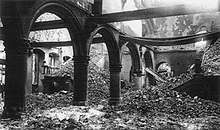
A Carnegie library was built in the 1920s for the University of Leuven to replace a building destroyed in the First World War.
Funding came from the Carnegie Endowment for International Peace, which also built libraries in the war-damaged cities of Rheims and Belgrade. The architect of the Leuven library was Whitney Warren. Although the architect was American, he employed a Flemish style for this commission. His building in turn suffered severe damage in the Second World War, but has been restored. (For more details of this library, see Catholic University of Leuven.)
France
The Carnegie library of Reims is the single Carnegie library in France. Reims was devastated in the First World War and the losses included library accommodation in the town-hall. The provision of a new library was conceived as a contribution to the city's reconstruction. Reims was one of three "front-line" cities to be given a Carnegie library, the other two being Leuven and Belgrade.
The Art Deco building was finished in 1927, and opened the following year in the presence of Gaston Doumergue, the French President and Myron T. Herrick, the US ambassador. The building was restored at the beginning of the 21st century. The library stock includes some material which survived World War I.[1]
Ireland
Carnegie libraries are to be found throughout Ireland.[2] Libraries vary considerably in size, some of the rural ones being very small, but the smallest must be the cabinets used for the Carnegie Library Lighthouse Service.
A full list and description of Carnegie libraries in Ireland can be found in Irish Carnegie Libraries: a Catalogue & Architectural History by Brendan Grimes (Dublin: Irish Academic Press, 1998). The examples listed below are in the Republic of Ireland.
- Cappoquin, County Waterford.
- Cork, foundation stone laid 1903; destroyed in the Burning of Cork
- Clondalkin,
- Clouncagh, County Limerick (1917)
- Dingle, County Kerry
- Dublin City Public Libraries and Archive
- Greystones
- Rathmines (1913)
- Pembroke, Anglesea Road (1929)
- Pearse Street
- Churchtown
- Glencullen, Dún Laoghaire–Rathdown, 1907.
- Skerries Library, Strand St, Skerries,North County Dublin. 1911,Still in use as a library. http://www.fingalcoco.ie/Library/
- Kenmare, County Kerry.
- Kilkenny city, John's Quay, 1910 – still in use as a library.
- Killorglin, County Kerry, 1909.
- Limerick city, 1906 – now the Limerick City Gallery of Art.
- Lismore, County Waterford, 1910.
- Waterford City Library, foundation stone laid 1903 – first Carnegie library in Ireland and still in use.
Serbia
The Belgrade University Library, Serbia, is a Carnegie library.[3] Much of Belgrade was destroyed in the First World War, and in the 1920s it became one of three "front-line" cities to receive a Carnegie library, the other two being Leuven and Rheims.
United Kingdom
The first Carnegie library to be built was in Scotland. The English Carnegie libraries began to be built at the beginning of the 20th century. Carnegie, who in his retirement divided his time between the USA and Scotland, opened some British libraries personally.
In Britain the process of applying for a Carnegie library was broadly similar to that in the USA. It was adapted to British legislation, e.g. the Public Libraries Act, which permitted expenditure from the rates on local libraries. Carnegie assessed applications using criteria which favoured poorer towns, but applicants had to undertake to support their library, providing it with books etc. from the rates. While most towns were very grateful to receive a grant, Carnegie's project was not without controversy. For example, some people objected to the way in which he had made his money. In the case of Stratford-on-Avon there were objections to the proposed building for conservation reasons, and this resulted in a library which blends into the half-timbered neighbouring buildings.[4]
Most Carnegie libraries served the general population of towns and cities, but he also provided some academic libraries in the UK. (This pattern of town and academic libraries was in line with his policy in the USA where he provided a number of college libraries, for example at Tuskegee University.[5]) In Stoke-on-Trent the Carnegie United Kingdom Trust funded a specialist ceramics library.[6] The existence of special collections with catalogues gave scope for the development of interlibrary loans.
From 1913 applications were handled by the Carnegie United Kingdom Trust,[7] based in Carnegie's home town, Dunfermline. The trust continued to fund libraries after Carnegie's death in 1919, but its priorities shifted to other areas of its charitable work.
Current status of Carnegie libraries
As at 2011 many of the UK's Carnegie libraries continue to be used for their original purpose. However, Carnegie libraries are being affected by local authority budget cuts which are reducing the number of public libraries across the country.[8]
The fate of library buildings which are closed is uncertain. It depends partly on heritage listing. The British system of designating listed buildings has tended to favour pre-20th century buildings, with the result that at the beginning of the 21st century some Carnegie libraries are unprotected and thus at the mercy of the developer once they are no longer required by the local authority. Over the years some Carnegie libraries have been demolished, e.g. Grays (details in the list below). On the other hand, new uses have been found for other Carnegie libraries, e.g. Pontefract's Carnegie library is now a museum.



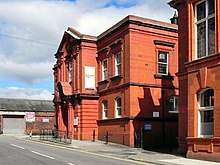
England
- London
- Brentford Library 1903, brick and terracotta construction, designed by Nowell Parr, Grade II listed.
- Bromley 1908, designed by Evelyn Hellicar (1862–1929),[9] now demolished.
- Crofton Park 1905, brick and stone (community run by Eco Communities and Lewisham Borough).
- Custom House, 1905, brick and stone. Still in use as Public Library.
- Deptford, 1914, brick and stone (closed 1991, now Lewisham Arthouse artists studios, public gallery and workshop).
- Enfield, 1912, heavily extended to the rear in 2010.
- Enfield Highway, 1910. Extended in 1938.
- Hanwell designed by T Gibbs Thomas in 1905/06 (run by London Borough of Ealing).
- Herne Hill 1906, Grade II listed (closed by London Borough of Lambeth 31 March 2016 due to budget cuts).
- Homerton 1913, Grade II listed (Chats Palace Arts Centre since 1976)
- King's College, London: The Carnegie Collection of British Music on loan to The Maughan Library.
- Kingston upon Thames 1903, Carnegie also funded the separate building for the Kingston Museum 1904.
- Lea Bridge Road, Leyton.
- Manor Park, 1905, brick and stone (library relocated 2012-2013).
- New Cross, 1911, brick and stone, designed by Gerald Warren & Stanley E Castle (now Music Room studios)
- Sydenham (run by London Borough of Lewisham).
- Teddington 1906, brick and stone construction.
- Thornton Heath.[10]
- Twickenham 1906/7.
- Walthamstow 1907-09.[11]
- Birmingham.[12]
- Aston Cross, 1903.
- Bartley Green 1905.
- Birchfield, extension 1904.
- Erdington 1907.
- King's Heath 1905, Renaissance classical style with art nouveau features Grade II listed.
- King's Norton 1906.
- Northfield Library 1906, destroyed by fire in 1914, reputedly the work of suffragettes, rebuilt using original facade.
- Rednal 1909.
- Selly Oak Library 1906.
- Stirchley 1907.
- Coventry
- Greater Manchester
- Castleton, Rochdale 1905
- Chorlton, Greater Manchester.
- Didsbury 1915.
- Eccles 1907.
- Levenshulme 1904.
- Milnrow, Greater Manchester.
- Stockport 1913, brick and stone construction. In control of Stockport Metropolitan Borough Council, still in use as Central Library.
- Wigan 1907, Ormskirk Road, Pemberton, Grade II listed. Library now closed, used as office space.
- Accrington 1907 (run by Lancashire County Council).
- Annfield Plain 1908 (run by Durham County Council).
- Ashby (now part of Scunthorpe). Opened April 1906. Built with a grant of £1,500.[14]
- Ashton-in-Makerfield 1906, Grade II listed in 2009.
- Barrow in Furness.
- Batley 1907.
- Bideford 1905.
- Birkenhead, demolished.
- Blackheath, opened 15 November 1909
- Blackpool 1911, Grade II listed.
- Brierley Hill, 1904, Designed by the borough surveyor to Brierley Hill, Lewis Harper and built by CA Horton.[15]
- Bolton on Dearne 1903, brick. One of the first Carnegie libraries outside Scotland. Formerly Council Offices, currently disused. Community group attempting to raise funds to restore the building and re-open it as a Fitness/Martial arts/Boxing centre for local youth.[16]
- Boston Opened 1904. Built as part of the Municipal Buildings with a grant of £560.[17]
- Bournemouth Four Carnegie Libraries:- 1907 Winton Branch Library, built with £2,000 from the Carnegie fund, opened on 26 October, by Mayor J. A. Parsons, Grade II listed in 1976; 1909 Springbourne Branch Library, built with £2,000 from the Carnegie fund, opened on 27 March, by Mayor G. E. Bridge; 1910 Boscombe Branch Library, built with £4,000 from the Carnegie fund, designed by Mt C. T. Miles, opened on 22 June, by Mayor G. E. Bridge (relocated to new buildings in 1965); 1916 Westbourne Branch Library, built with £2,000 from the Carnegie fund, opened on 13 May, by Mayor H. Robson, Grade II listed in 1976.[18]
- Bridgwater 1905, Edwardian Baroque style, Grade II listed.
- Calne 1905.
- Chadderton 1904-05 Former civic library, Jacobean Revival, designed by J Lindsay Grant of Manchester for Chadderton UDC with funding from Andrew Carnegie.Building was vacated for a new 'Civic Hub' in 2010 and now privately owned. Listed as Grade II in 2011.
- Chatham 1903. Demolished in the 1980s.
- Cleator Moor 1906, grade II listed
- Clitheroe 1905, grade II listed
- Cockermouth.
- Crosby 1905, brick and stone, Grade II Listed (closed by Sefton Metropolitan Borough Council in December 2013 - currently a local charity Regenerus[19] is working to develop it as a Carnegie-Crosby a 3rd space for the community).[20]
- Cradley Heath, built by Rowley Regis Urban District Council, opened 15 November 1909, Grade 11 Listed[21]
- Dalton-in-Furness 1905.
- Dartford Opened in 1916. Built with a grant of £7,4000, Red brick and Bath stone, Grade-II listed in 1975 (run by Kent County Council).
- Darwen 1908, Yorkshire stone.
- Derby, Pear Tree Road.
- Eastbourne Opened August 1904. Built with a grant of £10,000. Destroyed in an air raid 1943.
- Erith 1906, Grade II listed in 1996. Partly occupied, following relocation of the library in 2009.
- Farnworth, Bolton Metropolitan Borough, 1911.[22]
- Fenton, Staffordshire 1906, brick and stone construction (run by Stoke-on-Trent City Council) - closed 31 March 2011 due to budget cuts.
- Gainsborough Opened in October 1905. Built with a grant of £4,000.[17]
- Garston, Liverpool.
- Goole Opened in 1905 with a grant of £3,000. Demolished in the 1960s.
- Gorleston-on-Sea Opened in 1907. Demolished in 1975.
- Grantham Opened in 1926. Originally built to house the town's library and museum, with partial funding from the Carnegie UK Trust. The library has since been relocated, but the building has continued in use as a museum.[17]
- Gravesend Opened in 1905. Built with a grant of £6,000. Grade-II listed in 1975 (run by Kent County Council).
- Grays Free Library opened in 1903. Built with a grant of £3,000. Later demolished.[23] Replaced by Essex County Council cultural centre in 1968, with Library on ground floor (run by Thurrock unitary authority).
- Great Yarmouth Opened April 1907. Built with a grant of £5,000. Damaged in an air raid in 1941 and again in 1942. This library was subsequently demolished.
- Harrogate Opened in 1906. Built with a grant of £7,500. Re-opened in October 2010 following refurbishment (run by North Yorkshire County Council).
- Hove 1908, Renaissance style faced with stone, Grade II listed.
- Huthwaite opened 1913, now owned by Nottinghamshire County Council and still serving the people of Huthwaite
- Hull Opened in 1905. Built with a grant of £3,000. Grade II listed, now the "Carnegie Heritage Centre".
- Ilkeston.
- Irchester Opened November 1909. Built with a grant of £1,000.
- Keighley 1904, stone construction (run by Bradford Metropolitan District Council).
- Kendal 1909, stone construction (run by Cumbria County Council)[24]
- Kettering 1904, built with a grant of £8,450, a "jewelled casket of learning" opened by Andrew himself at age 68 years
- King's Lynn library, opened in 1905 and built with a grant of £5,000.
- Knutsford, red brick and terracotta construction, built in 1904. Now a day nursery.
- Langley, Sandwell, brick and terracotta construction.[25]
- Leicester Opened 1905 by Carnegie in person. Built with a grant of £12,000. Grade II listed.
- Loughborough, Leicestershire built in 1905
- Lincoln Opened 1913. Built with a grant of £10,000.[17]
- Littlehampton[26] 30 May 1906. Maltravers Road BN17 5NA. The extended & refurbished modern library[27] is run by West Sussex County Council.
- Lowestoft Opened May 1905. Destroyed in an air raid March 1941.
- Luton Opened 1st October 1910. Built with a grant of £12,000. Demolished in 1962 [28]
- Mansfield Opened May 1905. Built with a grant of £3,500.
- Melton Mowbray Opened 1905. Built with a grant of £2,000. Used as a public library until 1974; now Melton Carnegie Museum
- Middlesbrough Central library 1912.
- Neston 1907 (run by Cheshire West and Chester Council).
- Newbury Opened May 1906, Built with a grant of £2,000. Used as the town's public library until 2000.
- Newton-le-Willows 1909, Built with a grant of £4,000 (run by St. Helens Metropolitan Borough Council).
- New Mills 1910, Built with a grant of £2,000.[29]
- Normanton, West Yorkshire 1907, red brick.
- Northampton completed in 1910, to a design by Herbert Norman.
- Oswaldtwistle 1915 (run by Lancashire County Council).
- Penistone 1913, (now used as offices for Barnsley Council).
- Pontefract 1904, Art nouveau building which now serves as a museum.
- Portsmouth 1906, Edwardian baroque and free Renaissance style.[30]
- Peterborough Opened officially by Carnegie in May 1906. Built with a grant of £6,000. Used as the public library until 1990.
- Ramsgate, Kent 1904.
- Rawmarsh 1905.
- Rawtenstall .
- Royton 1907.
- Runcorn 1906, in local sandstone (run by Halton Borough Council.)
- Rushden Opened November 1905. Built with a grant of £2,000.
- St Albans Opened in 1911 on Victoria Street. Librarian - Ernest William Green. Fine Edwardian Baroque building. It is now a city centre pub.[31]
- St Annes-on-the-Sea (Lytham St Annes) 1906, brick and terracotta construction (run by Lancashire County Council).
- Sandown Opened July 1905. Built with a grant of £2,000, (run by Isle of Wight County Council, threatened with closure).
- Scunthorpe Opened February 1904. Used as a public library until 1974. Demolished c.1985.[17]
- Sefton Park, Liverpool 1911. Mock Tudor style building with a modern 1960s extension.[32]
- Sevenoaks Opened in November 1905. Built with a grant of £3,000. Used as a public library until 1986.
- Shipley, West Yorkshire 1905, stone construction. The building is no longer in use as a library.
Skipton, North Yorkshire 1910 operated by Craven District Council
- Solon Carnegie Library, no building provided. This academic library comprised books on ceramics. The collection is now in the Horace Barks Reference Library, Stoke-on-Trent.
- Southend-on-Sea, 1905, Public Library designed by Henry Hare. Since 1981, the building has been in use as the Central Museum, Southend.[33]
- Sowerby Bridge (Near Halifax) 1905, stone (run by Calderdale MBC)[34]
- Stamford, Lincolnshire Opened in 1906. Building converted for library use with a grant of £2,500. Grade II listed.,[35][36]
- Stapleford, Nottinghamshire 1906. Used as a public library until replacement by modern premises in 1981. Then fell into disrepair until purchased by Stapleford Town Council in 1987 and subsequently renovated and re-opened in 1988 as The Carnegie Centre. Now home to Stapleford Town Council.[37] In use as library during 2013 as the 1981 library is refurbished.
- Stourbridge, 1904, Grade II Listed[38]
- Stratford-upon-Avon, partly timber construction.
- Sunderland - Hendon 1908, Kayll Road 1909, Monkwearmouth 1909
- Taunton, Opened 1905, closed in 1996 and is now a wine bar.[39]
- Tividale, opened 15 November 1909, closed 1966.
- Tuebrook, Liverpool. Closed in 2006 due to health and safety concerns. Now being redeveloped as a community hub by local charity Lister Steps.[40]
- Tyldesley 1909, brick and stone construction.
- Walkley, Sheffield 1905, Grade II listed.
- Wallasey Central Library.
- Walsall Central Library, of red brick and stone. Opened 24 July 1906 at a cost of £8,000.[41]
- Wakefield 1905, stone. (Library now Closed), Replaced by a new Library and Museum within the Wakefield One Civic office building which opened to the public on Monday 29 October 2012, with the lending Library on the upper ground floor and local studies section and museum on the lower ground floor.[42] The building was converted by The Art House in 2014 into 34 artists' studios.[43]
- Wednesbury 1908, red brick and limestone at a cost of £5,000.
- West Bromwich 1907, Ruabon facing bricks with Portland stone and terracotta detailing.[44]
- Westhoughton 1906, situated at the rear of the Town Hall.[45]
- Workington 1904, built as a library and lecture hall. In use as a theatre & arts centre since 1973
- Worthing[46] 1908. Built by Worthing Corporation, the building survives as Worthing Museum & Art Gallery.[47] Today's library[48] was built next door, opened in 1975 and is run by West Sussex County Council.[48]

Scotland
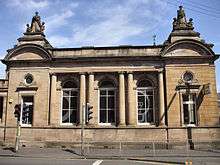
In Scotland the Carnegie libraries were typically built of stone.[49] In the rest of the British Isles there was much more use of brick. The drawings of the Carnegie libraries designed by architect James Robert Rhind are in the Strathclyde Archives, Glasgow.[50]
- Aberdeen Central Library 1892
- Airdrie Public Library 1894 and 1925
- Ayr 1893
- Bridgeton District Library, 1903 by architect James Robert Rhind (now used as Glasgow Women's Library)
- Bo'ness
- Burntisland
- Coatbridge library 1905 pink sandstone construction
- Dennistoun Library, 1905 by architect James Robert Rhind
- Ewart Library, Dumfries (named at Carnegie's suggestion after William Ewart)
- Dunfermline Carnegie Library, Dunfermline, 1883, the first Carnegie library
- Edinburgh, Central Lending Library 1890, French Renaissance style, by George Washington Browne.
- Govanhill & Crosshill District Library, 1906 by architect James Robert Rhind
- Grangemouth 1889, the second Carnegie library (which opened shortly before Braddock, the first Carnegie library in the USA).
- Hamilton townhouse library 1907
- Hugh Miller Institute, Cromarty, 1902 by architect Alexander Ross, named after local geologist and writer Hugh Miller.
- Hutchesontown District Library, 1904 by architect James Robert Rhind
- Iona, 1911.
- Kirkwall 1909, no longer in use as a library.
- Jedburgh
- Kinross
- Maryhill Public Library, 1903 by architect James Robert Rhind
- Maxton, Roxburghshire (Now used as a village hall).
- Montrose, Angus
- Motherwell
- Parkhead District Library, 1906 by architect James Robert Rhind
- Reading Rooms Dundee, 1910 by architect James Thomson
- Stirling Central Library, 1902 by architect Harry Ramsay Taylor
- Thurso, Highland 1910, by architect Sinclair MacDonald[51]
- Wick, Highland 1897
- Woodside Library, 1905 by architect James Robert Rhind
Wales
Carnegie's libraries were not exclusively for English-speakers. The Bangor library was called Llyfrgell Rydd ("Free Library" in Welsh).
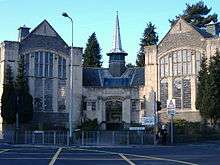
- Abergavenny
- Aberystwyth
- Bangor 1907, brick and stone construction
- Barry
- Bridgend, former Old Library 1906 now Carnegie House (2014), Council Offices and Arts/Culture Hub
- Canton, Cardiff
- Cathays, Cardiff 1907
- Coedpoeth 1904, local sandstone construction
- Llandrindod Wells
- Merthyr Tydfil
- Newport: Rogerstone Library 1905, Pillgwenlly Library and Corporation Road Library, Newport
Rhyl, Flintshire (now Denbighshire) 1907 no longer in use as a library
- Taibach, Neath Port Talbot
- Trecynon, opened 1903
- Whitchurch, Cardiff
- Wrexham
Northern Ireland
- Bangor, County Down, extended, but still in use as a library.
- Belfast (3 Carnegie libraries: Falls Road still in use as a library, Donegall Road and Oldpark Road no longer in use
- Portadown, County Armagh – no longer in use as a library.
- Lurgan, County Armagh, 1906 – still in use as a library.
- Larne, County Antrim, 1905 - now Larne Museum and Arts Centre.
References
- ↑ La Bibliothèque Carnegie Archived 8 September 2010 at the Wayback Machine.
- ↑ "Catalogue of the Photographic Exhibition of Irish Carnegie Libraries" (PDF). An Chomhairle Leabharlanna (Library Council of Ireland). Archived from the original (PDF) on 26 July 2011. Retrieved 4 September 2012.
- ↑ "University Library "Svetozar Marković"". University of Belgrade. Archived from the original on 12 October 2009. Retrieved 2009-06-18.
- ↑ "Carnegie and Corelli" New York Times article from 1903. (Carnegie libraries usually avoided using wood, although Stratford-on-Avon is not the only example of wooden construction, the material is used at Hull's Carnegie Heritage Centre, for example).
- ↑ Up from Slavery, Booker T. Washington refers to a grant received from Carnegie in 1900 to provide the college library.
- ↑ The Carnegie United Kingdom Trust has deposited historic files in the National Archives of Scotland in Edinburgh, where they are available to researchers
- ↑ "Improving Wellbeing in the UK & Ireland - Carnegie UK Trust".
- ↑ Tonmkin, Boyd (April 2011). "A fresh wind from the Humber". The Independent. Retrieved 4 December 2013.
- ↑ The Bromley Record, June 1906, page 98
- ↑ "Archived copy" (PDF). Archived from the original (PDF) on 3 March 2016. Retrieved 29 October 2012.
- ↑ http://www.walthamforest.gov.uk/listed_buildings%5Bpermanent+dead+link%5D
- ↑ The Fiftieth Annual Report of the Free Libraries Committee: April 1st, 1911, to March 31st, 1912 (City of Birmingham, Birmingham, 1912), pp. 9-10.
- ↑ "Foleshill Library's extension officially opened". Coventry Telegraph. Retrieved 21 October 2014.
- ↑ Lambourne, David. 'Lincolnshire's Carnegie Libraries', Lincolnshire Past and Present Vols. 85–90. Article can be accessed at the Internet Archive
- ↑ juliac2, Author (2016-09-24). "Brierley Hill library". The Carnegie legacy in England. Retrieved 2017-01-18.
- ↑ "B.O.D.Y. Carnegie Centre".
- 1 2 3 4 5 Lambourne, op. cit.
- ↑ The History of Bournemouth Libraries
- ↑ "Regenerus".
- ↑ "Carnegie Crosby - please come back frequently as we update this site with our latest news".
- ↑ England, Historic. "CRADLEY HEATH PUBLIC LIBRARY - 1229308| Historic England". historicengland.org.uk. Retrieved 2017-01-18.
- ↑ http://www.brianiddon.org.uk/speeches/20090327_FarnworthCentenary.pdf%5Bpermanent+dead+link%5D
- ↑ "History of Grays Library". Archived from the original on 8 June 2011.
- ↑ "Kendal Library - Visit Cumbria". www.visitcumbria.com. Retrieved 25 December 2017.
- ↑ Sandwell Metropolitan Borough Council
- ↑ "Search Results". www.westsussexpast.org.uk. Retrieved 25 December 2017.
- ↑ "Archived copy". Archived from the original on 24 July 2013. Retrieved 2 August 2013.
- ↑ {{cite web|url=http://carnegielegacyinengland.wordpress.com/category/bedfordshire/<
- ↑ "NEW MILLS - Story of New Mills Library".
- ↑ "History in Portsmouth, 'the Carnegie Library'. Accessed 24-11-08". Archived from the original on 20 January 2009.
- ↑ 1. Howard Green, grandson of the librarian. 2. Herts Advertiser April 1947
- ↑ "Archived copy". Archived from the original on 20 July 2009. Retrieved 21 July 2009.
- ↑ English Heritage. "British Listed Buildings (Public Library, Southend)". British Listed Buildings. Retrieved 13 March 2013.
- ↑ Street, Malcolm. "Sowerby Bridge Public Library".
- ↑ Lambourne, op. cit
- ↑ "LCC comments on Stamford Library" (PDF).
- ↑ "The Carnegie Centre: Stapleford Town Council". Archived from the original on 25 September 2013.
- ↑ juliac2, Author (2017-01-07). "Stourbridge library". The Carnegie legacy in England. Retrieved 2017-01-18.
- ↑ "Heritage Trail Leaflet 210x210mm:Layout 1" (PDF). Retrieved 2017-12-25.
- ↑ "Lister Steps".
- ↑ juliac2, Author (2016-10-09). "Walsall library". The Carnegie legacy in England. Retrieved 2017-01-18.
- ↑ "Wakefield One Library and Museum". Archived from the original on 23 January 2013.
- ↑ "The Art House, Old Library".
- ↑ juliac2, Author (2016-10-09). "West Bromwich library". The Carnegie legacy in England. Retrieved 2017-01-18.
- ↑ 1RU, Bolton Council, Town Hall, Victoria Square, Bolton, BL1. "Westhoughton Library".
- ↑ "Search Results". www.westsussexpast.org.uk. Retrieved 25 December 2017.
- ↑ Council, Worthing Borough. "Stories of Worthing".
- 1 2 "Archived copy". Archived from the original on 20 March 2013. Retrieved 2 August 2013.
- ↑ Scotland, Gerald Blaikie, Glasgow,. "Carnegie Libraries of Scotland".
- ↑ "James R. Rhind". Dictionaryofarchitectsincanada.org. Retrieved 2017-12-25.
- ↑ Scotland, Gerald Blaikie, Glasgow,. "Early Carnegie Libraries".
